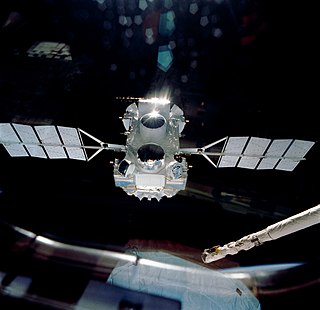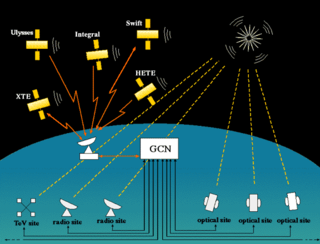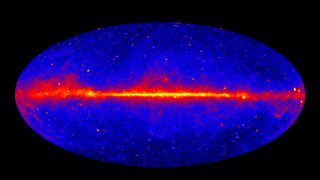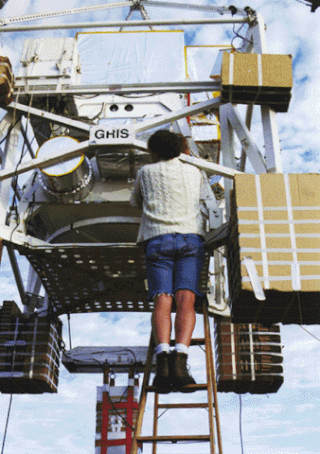
In gamma-ray astronomy, gamma-ray bursts (GRBs) are immensely energetic explosions that have been observed in distant galaxies, being the brightest and most extreme explosive events in the entire universe, as NASA describes the bursts as the "most powerful class of explosions in the universe". They are the most energetic and luminous electromagnetic events since the Big Bang. Gamma-ray bursts can last from ten milliseconds to several hours. After the initial flash of gamma rays, an "afterglow" is emitted, which is longer lived and usually emitted at longer wavelengths.

Teegarden's Star is an M-type red dwarf star in the constellation Aries, 12.5 light-years from the Solar System. Although it is near Earth it is a dim magnitude 15 and can only be seen through large telescopes. This star was found to have a very large proper motion of about 5 arcseconds per year. Only seven stars with such large proper motions are currently known. Teegarden's Star hosts a planetary system with at least three planets.

The Cosmic Background Explorer, also referred to as Explorer 66, was a NASA satellite dedicated to cosmology, which operated from 1989 to 1993. Its goals were to investigate the cosmic microwave background radiation of the universe and provide measurements that would help shape our understanding of the cosmos.

The Fermi Gamma-ray Space Telescope, formerly called the Gamma-ray Large Area Space Telescope (GLAST), is a space observatory being used to perform gamma-ray astronomy observations from low Earth orbit. Its main instrument is the Large Area Telescope (LAT), with which astronomers mostly intend to perform an all-sky survey studying astrophysical and cosmological phenomena such as active galactic nuclei, pulsars, other high-energy sources and dark matter. Another instrument aboard Fermi, the Gamma-ray Burst Monitor, is being used to study gamma-ray bursts and solar flares.

Centaurus A is a galaxy in the constellation of Centaurus. It was discovered in 1826 by Scottish astronomer James Dunlop from his home in Parramatta, in New South Wales, Australia. There is considerable debate in the literature regarding the galaxy's fundamental properties such as its Hubble type and distance. It is the closest radio galaxy to Earth, as well as the closest BL Lac object, so its active galactic nucleus has been extensively studied by professional astronomers. The galaxy is also the fifth-brightest in the sky, making it an ideal amateur astronomy target. It is only visible from the southern hemisphere and low northern latitudes.

The Compton Gamma Ray Observatory (CGRO) was a space observatory detecting photons with energies from 20 keV to 30 GeV, in Earth orbit from 1991 to 2000. The observatory featured four main telescopes in one spacecraft, covering X-rays and gamma rays, including various specialized sub-instruments and detectors. Following 14 years of effort, the observatory was launched from Space Shuttle Atlantis during STS-37 on April 5, 1991, and operated until its deorbit on June 4, 2000. It was deployed in low Earth orbit at 450 km (280 mi) to avoid the Van Allen radiation belt. It was the heaviest astrophysical payload ever flown at that time at 16,300 kilograms (35,900 lb).

Neil Gehrels Swift Observatory, previously called the Swift Gamma-Ray Burst Explorer, is a NASA three-telescope space observatory for studying gamma-ray bursts (GRBs) and monitoring the afterglow in X-ray, and UV/Visible light at the location of a burst. It was launched on 20 November 2004, aboard a Delta II launch vehicle. Headed by principal investigator Neil Gehrels until his death in February 2017, the mission was developed in a joint partnership between Goddard Space Flight Center (GSFC) and an international consortium from the United States, United Kingdom, and Italy. The mission is operated by Pennsylvania State University as part of NASA's Medium Explorer program (MIDEX).

The General Coordinates Network (GCN), formerly known as the Gamma-ray burst Coordinates Network, is an open-source platform created by NASA to receive and transmit alerts about astronomical transient phenomena. This includes neutrino detections by observatories such as IceCube or Super-Kamiokande, gravitational wave events from the LIGO, Virgo and KAGRA interferometers, and gamma-ray bursts observed by Fermi, Swift or INTEGRAL. One of the main goals is to allow for follow-up observations of an event by other observatories, in hope to observe multi-messenger events.

Nuclear astrophysics is an interdisciplinary part of both nuclear physics and astrophysics, involving close collaboration among researchers in various subfields of each of these fields. This includes, notably, nuclear reactions and their rates as they occur in cosmic environments, and modeling of astrophysical objects where these nuclear reactions may occur, but also considerations of cosmic evolution of isotopic and elemental composition (often called chemical evolution). Constraints from observations involve multiple messengers, all across the electromagnetic spectrum (nuclear gamma-rays, X-rays, optical, and radio/sub-mm astronomy), as well as isotopic measurements of solar-system materials such as meteorites and their stardust inclusions, cosmic rays, material deposits on Earth and Moon). Nuclear physics experiments address stability (i.e., lifetimes and masses) for atomic nuclei well beyond the regime of stable nuclides into the realm of radioactive/unstable nuclei, almost to the limits of bound nuclei (the drip lines), and under high density (up to neutron star matter) and high temperature (plasma temperatures up to 109 K). Theories and simulations are essential parts herein, as cosmic nuclear reaction environments cannot be realized, but at best partially approximated by experiments. In general terms, nuclear astrophysics aims to understand the origin of the chemical elements and isotopes, and the role of nuclear energy generation, in cosmic sources such as stars, supernovae, novae, and violent binary-star interactions.

Cornelis A. "Neil" Gehrels was an American astrophysicist specializing in the field of gamma-ray astronomy. He was Chief of the Astroparticle Physics Laboratory at NASA's Goddard Space Flight Center (GSFC) from 1995 until his death, and was best known for his work developing the field from early balloon instruments to today's space observatories such as the NASA Swift mission, for which he was the principal investigator. He was leading the WFIRST wide-field infrared telescope forward toward a launch in the mid-2020s. He was a member of the National Academy of Sciences and the American Academy of Arts and Sciences.

In cosmology, galaxy filaments are the largest known structures in the universe, consisting of walls of galactic superclusters. These massive, thread-like formations can commonly reach 50/h to 80/h megaparsecs —with the largest found to date being the Hercules-Corona Borealis Great Wall at around 3 gigaparsecs (9.8 Gly) in length—and form the boundaries between voids. Due to the accelerating expansion of the universe, the individual clusters of gravitationally bound galaxies that make up galaxy filaments are moving away from each other at an accelerated rate; in the far future they will dissolve.
The history of gamma-ray began with the serendipitous detection of a gamma-ray burst (GRB) on July 2, 1967, by the U.S. Vela satellites. After these satellites detected fifteen other GRBs, Ray Klebesadel of the Los Alamos National Laboratory published the first paper on the subject, Observations of Gamma-Ray Bursts of Cosmic Origin. As more and more research was done on these mysterious events, hundreds of models were developed in an attempt to explain their origins.

Gamma-ray astronomy is a subfield of astronomy where scientists observe and study celestial objects and phenomena in outer space which emit cosmic electromagnetic radiation in the form of gamma rays, i.e. photons with the highest energies at the very shortest wavelengths. Radiation below 100 keV is classified as X-rays and is the subject of X-ray astronomy.

OSO 3, or Third Orbiting Solar Observatory was launched on March 8, 1967, into a nearly circular orbit of mean altitude 550 km, inclined at 33° to the equatorial plane. Its on-board tape recorder failed on June 28, 1968, allowing only the acquisition of sparse real-time data during station passes thereafter; the last data were received on November 10, 1969. OSO 3 reentered the Earth's atmosphere and burned up on April 4, 1982.

Astrophysical X-ray sources are astronomical objects with physical properties which result in the emission of X-rays.

GRB 991216, nicknamed the Beethoven Burst by Dr. Brad Schaefer of Yale University, was a gamma-ray burst observed on December 16, 1999, coinciding with the 229th anniversary of Ludwig van Beethoven's birth. A gamma-ray burst is a highly luminous flash associated with an explosion in a distant galaxy and producing gamma rays, the most energetic form of electromagnetic radiation, and often followed by a longer-lived "afterglow" emitted at longer wavelengths.
The galactic ridge is a region of the inner galaxy that is coincident with the galactic plane of the Milky Way. It can be seen from Earth as a band of stars which is interrupted by 'dust lanes'. In these 'dust lanes' the dust in the gaseous galactic disk blocks the visible light of the background stars. Due to this, many of the most interesting features of the Milky Way can only be viewed in X-rays. Along with the point X-ray sources which populate the Milky Way, an apparently diffuse X-ray emission concentrated in the galactic plane is also observed. This is known as the galactic ridge X-ray emission (GRXE). These emissions were originally discovered by Diana Worrall and collaborators in 1982, and since then the origins of these emissions have puzzled astrophysicists around the globe.
David Louis Band or David L. Band was an astronomer who studied the theory of gamma-ray bursts.

The Gamma-Ray Imaging Spectrometer (GRIS) was a gamma-ray spectrometer instrument on a balloon-borne airborne observatory. It used germanium detectors to achieve high resolution spectroscopy. GRIS was operated from 1988 to 1995 by NASA's Goddard Space Flight Center, which called it "arguably one of the most successful gamma-ray balloon programs in history".
Allan Stanley "Bud" Jacobson was an American astrophysicist, known for his pioneering research in high-resolution gamma-ray spectroscopy.
















